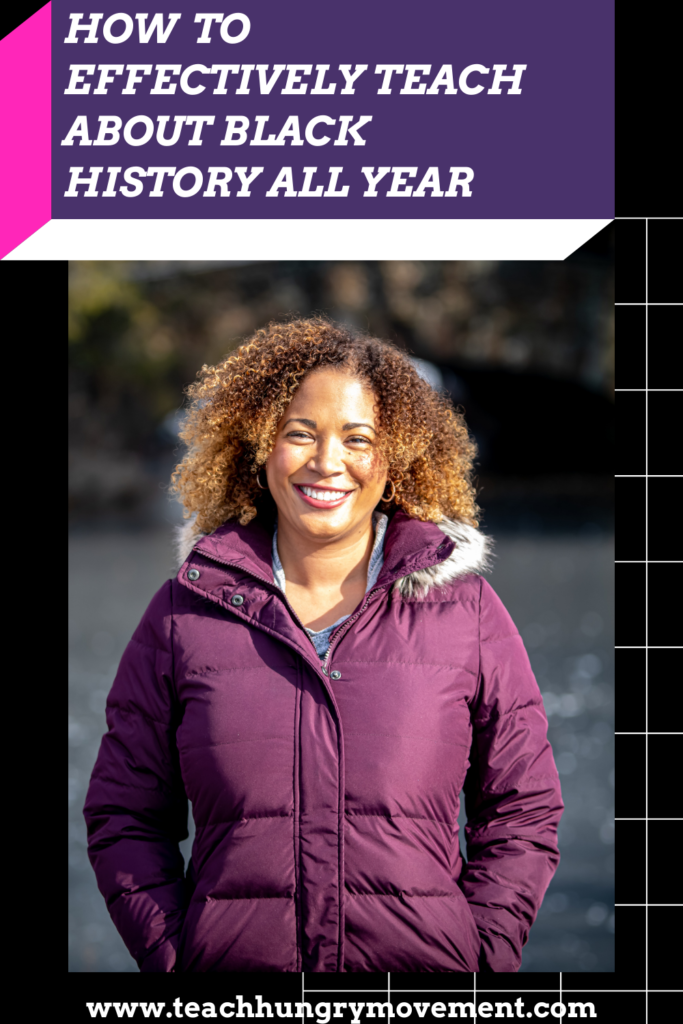Dream with me for a minute. Imagine we didn’t relegate teaching “non-white” history to designated “History Months?” I remember when I was a student teaching. My cooperating teacher was like, “it’s February, teach Black History. Next month teach Women’s History.” So that’s what I did.
Black History Month is essential.
It brings attention to and honors the contributions of Black people. It helps continue the conversation about issues Black Americans face.

Furthermore, it’s an excellent reminder that we need to tell all stories. That said, it is not the only time we should be teaching about this stuff. Assigning one month to teach Black History creates “otherness.” This otherness can lead to comments like the one from my former student.
Fortunately, the schools I’ve worked at have encouraged teaching history beyond a Euro-centric worldview. Additionally, I’ve worked with teachers eager to teach about marginalized groups. Groups who rarely get a fair shake and are often regulated to a paragraph or two in a textbook. Unfortunately, this isn’t the case everywhere.
For a lot of us, not teaching this history isn’t because of a lack of desire, it’s often because of a lack of know-how. So, I created a list of tips and suggestions to help you get started. This list will help you create interesting and thoughtful lessons. I’ve also included a free resource at the end of this post. Let’s dive into my tips for teaching Black History all year:
Tip #1: Talk About Topics In Order
If you’re anything like me, you’ve taught both chronologically and thematically. I prefer to teach chronologically. I find that my students “get it” better that way.
When you teach history in order, you can sprinkle in Black history. This way it won’t seem like a one-off topic. Or worse. Less important.
Remember, Black history IS American History (I know! So cliché). Without the contributions of African Americans, the United States would look very different.
Ok, ok. Let me not bash teaching thematically. I know there are merits to it. It’s just not what I do. And it’s not my area of expertise.
If you want to teach thematically, check out Let’s Cultivate Greatness‘s article about teaching thematically. Erin is an expert at teaching thematically, and her website is a great resource to help you get started!
Anyway, we’ve got to be real for a sec. Some things we teach the kids aren’t that important, and the kids don’t care about them. Before you come for me, remember, many kids won’t learn if they feel like the topics have nothing to do with them. Teens are selfish. It’s science. So make connections!
Need help with chronology? Here’s a quick list of SOME of the topics I discuss.
(It’s a lot. I definitely don’t get to everything every year. Also, some issues pertain more to my civics classes). A note: these are post-Reconstruction topics. That’s where the high school curriculum in most places I’ve taught starts.
- W.E.B. DuBois v. Booker T. Washington
- Ida B. Wells
- Ragtime
- Jim Crow
- Lynching
- Great Migration
- Harlem Hell Fighters
- Harlem Renaissance & Jazz
- The Blues
- Jesse Owens & 1936 Olympics
- Double V Campaign & Tuskegee Airmen
- Redlining
- Rock & Roll
- Emmett Till
- Civil Rights Movement including Malcolm X and the Black Panthers
- Vietnam War
- Hip Hop
- War on Drugs
- Race Relations in the 1990s
- Gentrification
- Affirmative Action
- Mass incarceration
- Police Brutality

Grab my FREE list of Top Ten Tips & Resources for Teaching Black History All Year!
Tip #2: Use Music
Music is one of my passions. The best music was invented right here in the United States, especially in the American South. And African Americans created or influenced much of American music. Jazz, blues, rock & roll, rap, and even country, have African Americans to thank.
In my experience, many students listen to rap. So, I love to end the school year with a mini-unit on hip-hop. But before we get to the creation of hip hop, we have to discuss the history of American music.
Again, this is something I do throughout the school year. At the end of each decade or unit. Also, music was an integral part of the Civil Rights Movement, so I use it daily during that unit.
Tip #3: Choose the lens of resilience rather than the lens of oppression
We can’t talk about black folks in America without discussing oppression. But that’s not the only story. We can’t just teach about victimhood. This leads us into the murky waters of the “White savior.” (If you don’t know what that is, I will talk about it in a future post).
It is vital to address resilience and resistance as well.
It’s important for kids to understand how Black people bettered their circumstances.
How about topics that don’t have to do with either? It’s refreshing to discuss contributions from Black people that don’t have to do with overcoming something.
BONUS TIP:
Another thing I always talk about is the concept of white guilt. I’ve had several white students feel bad about this history. They feel like they are in some way responsible. I don’t ever want them to feel put on the spot or blamed for past injustices.
As the teacher, you’ve got to let them know they are in a safe space. Make it clear that you are talking about people in history. Yes, these people did bad things, but that doesn’t mean your students have done bad things. Teach them how they can be allies. Above all, it is crucial to have this conversation BEFORE talking about these topics.
And yes, I know states are passing laws banning these types of conversation for this exact reason. It’s uncomfortable. But it’s ok to be uncomfortable. It’s how we make a change.
Tip #4: Discuss Contemporary Issues
This is one of the most challenging tasks we have as teachers. We have so much to cover during the school year. But, discussing current issues could be the most important and impactful thing we can do. Now more than ever. So, I try to carve out time to discuss current issues whenever I can.
Some of my favorites are gentrification, police brutality, and mass incarceration. If the kids are into it, I’m teaching it. No, we don’t have all the time in the world to teach everything we want.
But, it’s important to try.
This not only teaches kids that many issues about race still exist. (This is so freaking obvious, but there are still people who think we live in a “Post-Racial” America). It also validates many of the problems students might dealing with.
Tip #5: Don’t Forget About World History
Much of the time, when we think about Black History, we think about Black Americans. While that’s all well and good, there are Black people all over the world. How can you include them using the same strategies I discuss above?
What topics are you already teaching about? What can you add?
Check out my posts about Imperialism in Africa and the Haitian Revolution for some ideas about how to incorporate the Black experience in your World History classes. Before discussing any of these other topics, make sure to discuss pre-colonial Africa.
Tip #6: Talk About Black Joy
Talking about positive aspects of the Black experience is an important part of the narrative. So often, we discuss oppression and resistance to that resistance. That is not the only experience of Black people in history. And it negates the positive contributions that Black people have made for the United States and the world. Contributions that don’t revolve around fighting for freedom.
Need ideas? Consider the following:
- Music
- Art
- Black-owned business
Need more ideas? Ask people! People are happy to share their experiences as long as you are respectful.
Tip #7: Educate Yourself
Now you might be saying to yourself, “but I don’t know enough to teach about this stuff.”
Hey, as long as you’re open to learning, you can teach it. I remember showing one of my colleagues I lesson I do on lynching, and she asked me, “how do you know all this?”
It’s from educating myself.
I’ve participated in several PDs, read books, and watched documentaries. I took classes in college. I also participated in a summer program through the National Endowment of Humanities. It focused on a subject relating to African Americans. It’s taken years.
And I’m still learning. I know I teach much better when I am confident about the issue. I encourage you to learn more, so you can continue teaching Black History all year. Start with a book. Check out a documentary. Following people doing this work on Instagram. Just start.
BONUS: Black History Didn’t Start With Slavery
Remember, the Black experience didn’t begin with slavery. We must start our discussion well before then.
Well, there you go! I hope you found this helpful!
Want more resources? Check out these lessons!
For more info on how to teach Black history and other social justice education issues, click here to check out the Teach Hungry Movement.
Have questions, comments, or suggestions? Want clarification?
Leave a comment below!
+ show Comments
- Hide Comments
add a comment